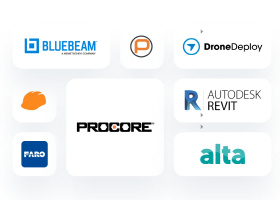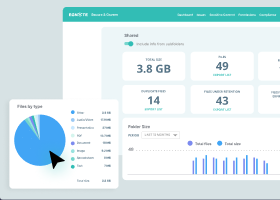Mastering Construction Document Control: A Comprehensive Guide for Engineers and Architects
Let’s jump in and learn:
- What Is Construction Document Control?
- What Are the Basic Methods of Document Control?
- What Are Documentation Procedures?
- Setting Up a Document Control System
- What Happens When Construction Document Control Fails?
- How Can Organizations Improve Document Control Processes?
- Construction Document Control Delivers Results that Outweigh the Effort
What Is Construction Document Control?
Construction document control is a part of project management, focusing on all related documents that set forth the scope and details of construction and post-occupancy operations. Construction document control includes proposals, contracts, technical specifications, design specifications, plans, change orders, revisions, punch lists, and manuals.
Construction document control establishes and enforces processes and procedures across a construction project. When systems are used as part of construction project management, team members and managers are better able to manage, access, and share documents with all stakeholders (e.g., internal, partners, clients, and inspectors).
With construction document control, the creation, review, modification, issuance, distribution, and accessibility can be directed, managed, and monitored more easily. It also ensures that documents are up to date and accurate, that a history of versions is maintained, and that they are readily available for management or third parties, such as inspectors.

Key functions of construction document control are to:
- Archive past-project documents in a way that they can easily be retrieved after the project has been completed
- Enable collaboration between people inside and outside of the organization, such as between:
- Office and job sites
- General contractors, architects, engineers, and subcontractors
- General contractors and clients
- Ensure disparate documents remain organized
- Increase efficiency with ready access to information
- Keep all documents from a project in a central location where all stakeholders can easily access them from where and when they are needed
- Provide data protection to restrict access to sensitive documents and prevent tampering
- Reduce administrative overhead by streamlining information sharing and communications
Eight of the essential features of a construction document control system are:
1. Access controls
2. Access monitoring and alerting
3. Auto-deletion of outdated documents based on rules
4. Document storage
5. Document version and edit history
6. Mobile device access
7. Search capabilities
8. Version rollback capabilities
What Are the Basic Methods of Document Control?
There are two basic methods for construction document control—on-premises and cloud.
On-Premises Construction Document Control Systems
An on-premises construction document control system is usually seen in larger organizations with the staff and resources to support it.
| Pros of on-premises construction document control systems | Cons of on-premises construction document control systems |
| More control of the system’s security and uptimeNo need for internet connectivity to run it | High up-front costsIT support expensesSoftware license management |
Cloud-Based Construction Document Control Systems
With cloud-based construction document control, systems are hosted and accessible online. Small and large organizations use these systems.
| Pros of cloud-based construction document control systems | Cons of cloud-based construction document control systems |
| No need for in-house IT supportAccess system from anywhere with an internet connectionData automatically backed upElastic storage capacity | Dependent on a provider to keep the system up and runningUnable to access without an internet connection |
What Are Documentation Procedures?
- Documentation procedures direct the day-to-day operations of construction document control systems. They include:
- Document creation (who and how)
- Obsoleting and destroying documents
- Publishing documents
- Review, approval, and revision of documents
- Utilization coding systems
Setting Up a Document Control System
Step 1
Inventory and evaluate all existing documents, the associated workflows, and the life cycle, delegating to project team leaders to handle the documents under their control.
- Contain critical, sensitive, or private information
- Have periodic updates
- Include content of legal significance
- Need to be managed within the construction document control system
- Require strict version control
- Will need to be destroyed or archived, at which point
Step 2
Determine ownership and requirements for minimum quality standards for documents.
- Assign responsibility for each document as related to approvals, releases, and whether it is archived or destroyed at the end of life
- Create a set of standard operating procedures to be applied to different document types, including quality standards.
- Define specific processes for approvals, such as are signatures required before the release
- Specify if a document requires legal or executive review
Step 3
Implement protocols for systematically naming and classifying documents to ensure consistency and make retrieving them easy.
- Classify documents according to their purpose or department
- Establish naming conventions to be used for all documents
- Include metadata when saving documents, following protocols to ensure consistency
- Use unique, easy-to-understand identifiers for all document names
Step 4
Create revision protocols and procedures to govern changes to documents.
- Assign someone from the project team that created the document to oversee changes
- Establish rules for periodic revisions of documents, including who is allowed to make revisions
- Keep a record of a document’s name, responsible staff members, review dates, and descriptions of the changes.
- Provide guidelines for document review and revision to specify when this should be done (e.g., during periodic audits, as changes occur)
- Save final versions in a read-only format or use access controls to restrict unauthorized updates
Step 5
Implement security and access control systems and policies.
- Control access to physical files, shared drives, and applications
- Have a backup system to provide resiliency in the event of unauthorized access
- Protect critical, sensitive, or personal information
- Restrict access to only authorized users
Step 6
Ensure version control by archiving and destroying documents.
- Establish archiving and destruction procedures
- Label documents as archived or obsolete as part of a document classification process
- Set a schedule for outdated documents that should be archived or destroyed
What Happens When Construction Document Control Fails?
When construction document control is mismanaged, several issues arise—with varying consequences. Seven common consequences of failed construction document control are:
1. Confusion with versions when version controls are not used properly
2. Difficulties accessing documents when construction document controls are a mix of digital and paper
3. Exposure in the case of audits or litigation when documents cannot be produced for review or validated
4. Overruns on expenses and scheduling delays
5. Permission blocks due to poorly implemented access controls
6. Rework creating documents when originals have been modified without permission or lost
7. Wasted time due to a lack of enforcement of naming and categorization, making it difficult to find documents
How Can Organizations Improve Document Control Processes?
Ten ways to improve construction document control are:
1. Assess current processes for construction document control
2. Assign someone to own the project and drive accountability across teams
3. Build-in security throughout the system, including in processes
4. Consolidate and centralize documentation
5. Create a single source of truth for documents and data
6. Digitize paper documents and automate processes
7. Establish streamlined and standardized workflows
8. Digitize and automate processes
9. Implement a system that fits the organization’s requirements, standardize construction document control with one system, and integrate it with other systems
10. Take advantage of automation capabilities
Construction Document Control Delivers Results that Outweigh the Effort
Construction document control is considered by many to be a tedious and time-consuming task. Getting it set up can be, but construction document control continues to be proven effective. Even those who become the most annoyed with it agree that construction document control is well worth the effort because it saves time, reduces friction, helps with numerous document retrieval use cases, and makes construction project management more efficient.
With paper files becoming obsolete, construction document control is becoming a must-have tool. Without it, even small projects become more complex. There are several approaches to construction document control. Getting started with construction document control is imperative; even a simple solution will deliver material results.
Egnyte has experts ready to answer your questions. For more than a decade, Egnyte has helped more than 16,000 customers with millions of customers worldwide.
Last Updated: 23rd February, 2023



